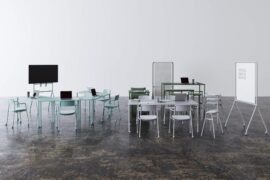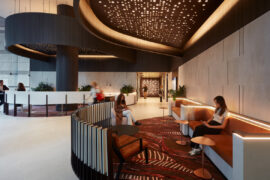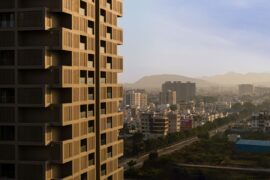With FRONT less than two weeks away, we caught up with Featured Speaker and Spitfire Control founder Max Thomson for his thoughts on the design and development process driving today’s commercial projects.

Ever wondered what project managers really do? We caught up with Spitfire Control founder and FRONT Featured Speaker Max Thomson to find out. Read on for Max’s thoughts on the evolution of commercial spaces, the necessary components of a successful project, and whether designers are over-providing in the name of amenity and agile workspaces. Max will be moderating “Design as Ecosystem”, the first session in FRONT Design Forum’s action-packed two-day program.
Read more interviews in this series here and register for FRONT today.
Max Thomson:Tell us a bit about yourself: how did you end up in your current role, and what does your average day at work entail?
Technically I’m a Project Manager but, really, I’m the clean-up guy. I just clean up the mayhem that is created by the interior design process. Designers these days – and even builders – are so much better than they used to be in terms of really knowing what they’re doing. So my role is to sit off at the side, watch what’s going on, and just gently steer people The original Spitfire’s role was protect and clear the path for the bombers who were doing the heavy work. A good project manager is the same. We keep away the extraneous influences so that the creative team can focus on what they do best – create. I just wish that they were better at it, but that is a story for another day.
By qualification I’m an industrial designer, so I can design toothbrushes and plastic mouldings, things like that. That was in England back in the 1980s, but that was never particularly exciting for me. I’ve been through various iterations: I worked on a construction site in America; I’ve renovated houses in Italy… I came to Australia in 1989 on holiday and got a job with Davenport Campbell as an interior designer and just worked my way through the ranks of interior design until – and I’m not kidding – I had a beer and pizza with a mate of mine who ran one of the big building companies. And I was saying how annoying project managers are from a designer’s point of view because they get in the way, and he said that was funny because for the builder, the project manager was also always getting in the way. We said, “I’m sure we can do better.” And the next day he rang me up and said, “Ok, I’ve quit.” I went, “You what? How many beers did we have last night?” And that’s how we started the project management company.
Pretty much! We put an advert in the Yellow Pages, and Citibank rang us up. We couldn’t believe it. From there, it sort of morphed into design and construction, and then in 2012 [my business partner] had a bit of an epiphany and decided that he wanted to do something else so that business finished up and I started Spitfire. One of the reasons why it’s called Spitfire is because only one person can fly a Spitfire; I don’t have any staff and I don’t want any.
Partly because I don’t want the headache. Primarily, it’s because I actually really enjoy what I do and I know that when you manage a business you don’t do what you love to do – you manage people doing what you love to do. When my clients ring me and ask “what’s happening here or going on there?” or “do you know about this?” I do know, because I’m doing it. From a client experience point of view they often tell me that it’s so much better because there’s a senior person on the job 100% of the time. Obviously having holidays can be a bit of a challenge, but you take the rough with the smooth.
As far as there is an average day, it’s paperwork associated with approvals, budget, and program. Those are probably the 3 key areas. It’s a lot of meetings. It’s either running the weekly project meetings and preparing minutes of them or its making sure and reminding people that they need to do X, Y, and Z. So there’s a lot of time on the phone, a fair bit of time emailing and, interestingly, as much time as I can just thinking. I do quite a lot of looking out the window because a good project manager is always looking ahead and doing all the stuff that you don’t want the designer to be wasting their time doing. I want designers to be looking out the window creating, holding a pencil and coming up with something new. I don’t want them to be thinking about budgets, programs, statutory approvals, and client issues. That’s my job.
When I started my first job in London in 1985, we were drawing with Rotring pens on tracing paper, making doilies with the razor blades to erase mistakes and getting high on the dyeline machine. I still remember my first boss asking me if we should buy a fax machine. I said no, because no one else had one so there was no one to send them to. Fast forward 30 plus years and we have all but gotten rid of paper, let alone facsimile and even drawing in two dimensions. The change has been remarkable. If I had to pick one thing [that has driven change] it would be email. There is a very real danger in the ability to respond quickly – and the urge to check it at ungodly hours is a problem – but generally it is wonderful. Not just for the ease of communication but for the permanent, accurate, and searchable trail it leaves. No longer do we need to keep records of phone conversations or argue about who said what, when. And yet, I wonder if we have lost something in all this. Of course there have been improvements in wellness, sustainability, ergonomics, and collaboration but – and this isn’t a popular view – at the end of the day we go to work to be productive and I am not convinced that access to chai lattes and ping pong actually facilitate that. I work for myself and mostly on my own. I get a lot done because I can control my environment and manage my time to suit my life. In a large office with constant activity I frankly don’t know how people get things done.
Yes, I strongly do. I don’t know whether it’s the client asking for it or the designer offering it, and my suspicion is that it’s the designer offering it. There are some clients – you know the high tech Silicone Valley clients – that clearly have the motivation to deliver all of that stuff to their people and they’re famous for it. But I think that designers as a fraternity probably push a lot of shiny rubbish on them that they don’t necessarily want or need but are too scared to say, “Oh I don’t get that” or “Why do I need one of those things?” I walk through a lot of spaces that cost a lot more than they needed to and have parts of them that are obviously underutilised because corporate culture hasn’t kept up. You need a pretty liberal or mature organisation for people to feel comfortable going to sit in a corner on a futon pretending they’re working. And most people aren’t like that.
A few years ago I did a fitout for a major international bank – it was just after Macquarie Bank finished Shelley Street. I sat down with the CFO of and said, “So, you’ve obviously seen Shelly Street. Macquarie Bank claim that’s actually attracting staff to go and work with them because of the work environment.” And he said to me, “If one of my staff came up to me and said, ‘I’m going to work at Macquarie because of the fitout at Shelley Street, I will pack up their box and I will walk down there and shake their hand as they go.’” I’m just not convinced that every client needs and wants a lot of the shiny stuff they’re given.
Absolutely. There is one designer I can think of where every job looks the same. You see it in a picture and immediately go, “I know that was designed by that person.” It might be a bank or an insurance company or whatever – they’re all the same. It’s good, but it makes a mockery of the principle of taking a brief.
It’s so important that the rank and file staff know why the fit out has been designed the way that it has, how to use it and not to use it, and have a respect for it as something more than just decorative. A lot of the designers are very good and there are reasons behind the way they do things, but unless it’s explained to people it’s just decoration.
The best projects have a leader from the organisation who has a very clear direction and knows where you’re going. I worked on a project where the client was based in San Francisco and was a bit wishy-washy. There was a local guy who was not supported in his role and then there were 10 other stakeholders: there was a guy responsible for health, there was a guy responsible for AV, there was someone responsible for the gym… there was someone responsible for everything. It was ridiculous. None of them talked to each other because they all had different reporting lines within the organisation, none of them cared about the budget, none of them cared about the program – they just cared about making sure that their bit was best. So it was a completely untenable position because there was no escape valve to manage these conflicting requirements. I was in a no-win situation, as was the design firm. We got the job done and it looks great, but it was very sour, and I’ve never worked with them again. Whereas on the flipside, when I get a lovely client who respects what I do and works with me rather than against me it’s a collaborative experience, and those are fantastic jobs.
The next big step needs to be geographic. If you look at the majority of the old economies – the UK, Germany, France, USA – they have multiple cities that support industry and substantial office space. Not just London, but Manchester, Liverpool, Birmingham, Bristol, Cardiff, Newcastle, etc. However here in Australia we have Sydney, Melbourne, and Brisbane, plus some opportunistic industry-based workplaces in other places like Adelaide, Newcastle and Perth. We need a Government with foresight beyond the next election to actually build infrastructure to allow business to expand to regional Australia. Imagine if we had spent $50 billion on fast rail linking Orange and Bathurst to Sydney, and Daylesford and Ballarat to Melbourne instead of a pointless, old technology NBN. We could then create workplaces that embraced their communities in a genuine way rather than this somewhat artificial and manufactured manner that we see now. We could grow a sound regional Australia and release Sydney from the daft daily gridlock that shackles us. We can then utilise a decentralised office model. I can see a time, soon, when landlords will be building fitouts themselves and rental will be a user pays, drop in arrangement. Fundamentally we all do the same thing: use a computer, a mobile phone, and access data. Why should I go into the same place every day and all day to do that? My generation wouldn’t cope but we will all be moving to the coast soon anyway. The bulk of the 2020s workforce think less about place in a physical sense and will find their community through electronic means.
I’m very excited about VR. I think from many, many angles – if you will excuse the awful pun – it would be wonderful from a client experience point of view. After design presentations I always ask my clients if they know what they’re getting, and they always sort of look at me and say, “Yeah… sort of.” You’d be amazed by the number of times the client will walk onto a site at the end of their job and go, “Wow, I didn’t know I was getting X, Y, Z!” Equally, I walk on site and there will be really obvious mistakes that designers have made through coordination mistakes, and you just go, “How does that happen?” If there was proper VR – and I’m talking about fully immersive, goggles on, walk around a space kind of stuff – all this wouldn’t happen. And that will be a very exciting world.
Join Max Thomson and other industry heavyweights at FRONT this 9-10 August to hear more about the ideas that are driving change in the Australian commercial design landscape.
Max will be moderating the “Design as Ecosystem” session on Thursday, 9 August. Register for the session and the inaugural FRONT event here.
INDESIGN is on instagram
Follow @indesignlive
A searchable and comprehensive guide for specifying leading products and their suppliers
Keep up to date with the latest and greatest from our industry BFF's!

How can design empower the individual in a workplace transforming from a place to an activity? Here, Design Director Joel Sampson reveals how prioritising human needs – including agency, privacy, pause and connection – and leveraging responsive spatial solutions like the Herman Miller Bay Work Pod is key to crafting engaging and radically inclusive hybrid environments.

Welcomed to the Australian design scene in 2024, Kokuyo is set to redefine collaboration, bringing its unique blend of colour and function to individuals and corporations, designed to be used Any Way!

It’s widely accepted that nature – the original, most accomplished design blueprint – cannot be improved upon. But the exclusive Crypton Leather range proves that it can undoubtedly be enhanced, augmented and extended, signalling a new era of limitless organic materiality.

Not many commercial buildings in Sydney’s CBD can boast a 2020 completion date. But one boutique office building, situated at 275 George Street, forged through to cut the ribbon and stake its future in shifting sands.

Blending the old with the new, Grimshaw’s latest project with Carr is a beacon of architectural expression that sits perfectly within the city skyline.
The internet never sleeps! Here's the stuff you might have missed

In commercial interiors, flooring needs to do more than ground a space, it should tell a story. Through collaboration with the industry’s leading lights, Designer Rugs creates custom rugs & bespoke carpet solutions, finding ways to elevate commercial environments with material nuance and design integrity.

Screen 504 is a multi-residential building that pays homage to the past by reinterpreting traditional design for the future.